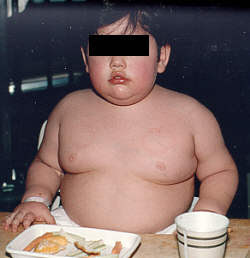
Prader-Willi syndrome (Summarized By Me)
simplified
Prader-Willi syndrome (abbreviated PWS) is a very rare genetic disorder, in which seven genes (or some subset thereof) on chromosome 15 are missing or unexpressed (chromosome 15q partial deletion) on the paternal chromosome.
Diagnosis/testing
genetic testing, specifically DNA-based methylation testing to detect the absence of the paternally contributed Prader-Willi syndrome/Angelman syndrome (PWS/AS) region on chromosome 15q11-q13. Such testing detects over 97% of patients. Methylation-specific testing is important to confirm the diagnosis of PWS in all individuals, but especially those who are too young to manifest sufficient features to make the diagnosis on clinical grounds or in those individuals who have atypical findings.
PWS phenotype
Clinical Features
Clinical Features
In Utero:
Reduced fetal movement
Frequent abnormal fetal position
At Birth:
Often breech or caesarean births
Lethargy
Hypotonia
Feeding difficulties (due to poor muscle tone affecting sucking reflex)
Difficulties establishing respiration
Hypogonadism
Infancy:
Failure to thrive (continued feeding difficulties)
Delayed milestones/intellectual delay
Excessive sleeping
Strabismus
Scoliosis (often not detected at birth)
Childhood:
Speech delay
Poor physical coordination
Hyperphagia (over-eating) from age 2 - 4 years. Note change from feeding difficulties in infancy
Excessive weight gain
Adolescence:
Delayed puberty
Short stature
Obesity
Extremely flexible
Adulthood:
Infertility (males and females)
Hypogonadism
Sparse pubic hair
Obesity
Hypotonia
Learning disabilities/borderline intellectual functioning (but some cases of average intelligence)
Proneness to diabetes mellitus
Extremely flexible
General physical appearance (adults)
Prominent nasal bridge
Small hands and feet
Soft skin, which is easily bruised
Excess fat, especially in the central portion of the body
High, narrow forehead
Almond shaped eyes with thin, down-turned lips
Light skin and hair relative to other family members
Lack of complete sexual development
Always picking at their skin
Stria
Delayed motor development
Reduced fetal movement
Frequent abnormal fetal position
At Birth:
Often breech or caesarean births
Lethargy
Hypotonia
Feeding difficulties (due to poor muscle tone affecting sucking reflex)
Difficulties establishing respiration
Hypogonadism
Infancy:
Failure to thrive (continued feeding difficulties)
Delayed milestones/intellectual delay
Excessive sleeping
Strabismus
Scoliosis (often not detected at birth)
Childhood:
Speech delay
Poor physical coordination
Hyperphagia (over-eating) from age 2 - 4 years. Note change from feeding difficulties in infancy
Excessive weight gain
Adolescence:
Delayed puberty
Short stature
Obesity
Extremely flexible
Adulthood:
Infertility (males and females)
Hypogonadism
Sparse pubic hair
Obesity
Hypotonia
Learning disabilities/borderline intellectual functioning (but some cases of average intelligence)
Proneness to diabetes mellitus
Extremely flexible
General physical appearance (adults)
Prominent nasal bridge
Small hands and feet
Soft skin, which is easily bruised
Excess fat, especially in the central portion of the body
High, narrow forehead
Almond shaped eyes with thin, down-turned lips
Light skin and hair relative to other family members
Lack of complete sexual development
Always picking at their skin
Stria
Delayed motor development
Neuro-cognitive
Individuals with PWS are at risk of learning and attention difficulties. Curfs and Frym (1992) conducted research into the varying degrees of learning disability found in Prader Willi Syndrome (PWS).[5] Their results were as follows:
5%...IQ above 85 (Average to low average intelligence)
27%..IQ 70 - 85 (Borderline intellectual functioning)
34%..IQ 50 - 70 (Mild intellectual disability)
27%..IQ 35 - 50 (Moderate intellectual disability)
5%...IQ 20 - 35 (Severe intellectual disability)
<1%..iq>
Individuals with PWS are at risk of learning and attention difficulties. Curfs and Frym (1992) conducted research into the varying degrees of learning disability found in Prader Willi Syndrome (PWS).[5] Their results were as follows:
5%...IQ above 85 (Average to low average intelligence)
27%..IQ 70 - 85 (Borderline intellectual functioning)
34%..IQ 50 - 70 (Mild intellectual disability)
27%..IQ 35 - 50 (Moderate intellectual disability)
5%...IQ 20 - 35 (Severe intellectual disability)
<1%..iq>
Behavioral
Prader-Willi syndrome is also frequently associated with an extreme and insatiable appetite, often resulting in morbid obesity. There is currently no consensus as to the cause for this particular symptom, although genetic abnormalities in chromosome 15 disrupt the normal functioning of the hypothalamus.[6] Given that the hypothalamus regulates many basic processes, including appetite, there may well be a link. However, no organic defect of the hypothalamus has been discovered on post mortem investigation.[6]
Prader-Willi syndrome is also frequently associated with an extreme and insatiable appetite, often resulting in morbid obesity. There is currently no consensus as to the cause for this particular symptom, although genetic abnormalities in chromosome 15 disrupt the normal functioning of the hypothalamus.[6] Given that the hypothalamus regulates many basic processes, including appetite, there may well be a link. However, no organic defect of the hypothalamus has been discovered on post mortem investigation.[6]
Endocrine
There are several aspects of PWS that support the concept of growth hormone deficiency in individuals with PWS. Specifically, individuals with PWS have short stature, are obese with abnormal body composition, have reduced fat free mass (FFM), have reduced LBM and total energy expenditure, and have decreased bone density.
PWS is characterized by hypogonadism. This is manifested as undescended testes in males and benign premature adrenarche in females. Testes may descend with time or can be managed with surgery or testosterone replacement. Adrenarche may be treated with hormone replacement therapy.
Treatment
Prader-Willi syndrome has no cure. However, several treatments are in place to lessen the condition's symptoms. Growth hormone replacement therapy improves body composition and increases linear height. During infancy, subjects should undergo therapies to improve muscle tone. Speech and occupational therapy are also indicated. During the school years, children benefit from a highly structured learning environment as well as extra help. Throughout their lives, the subject's food should literally be kept under lock and key, since the largest problem associated with the syndrome is severe obesity.
Because of severe obesity, obstructive sleep apnea is a common sequela, and a CPAP (continuous positive airway pressure) machine is often needed.
3 comments:
Thank you
It is wonderful article
www.medscape.com
Nice article.
I was searching for this info.
Thabks to you
I watched LASIK video it was informative
Post a Comment